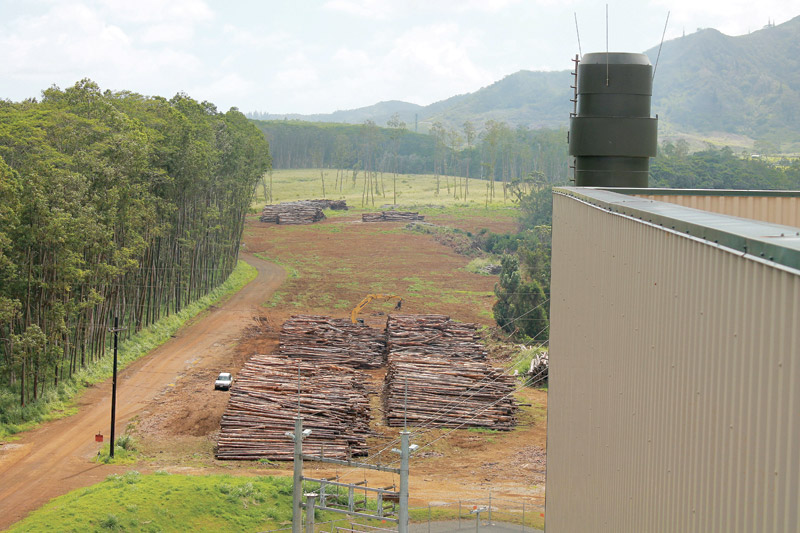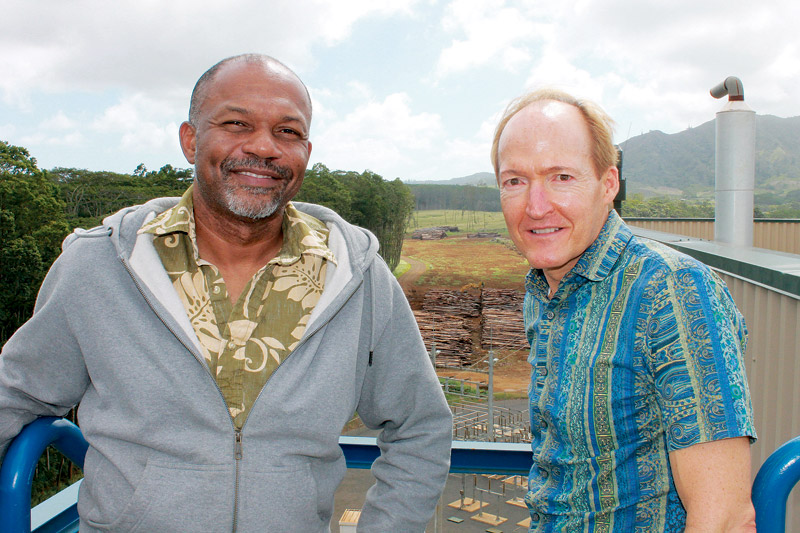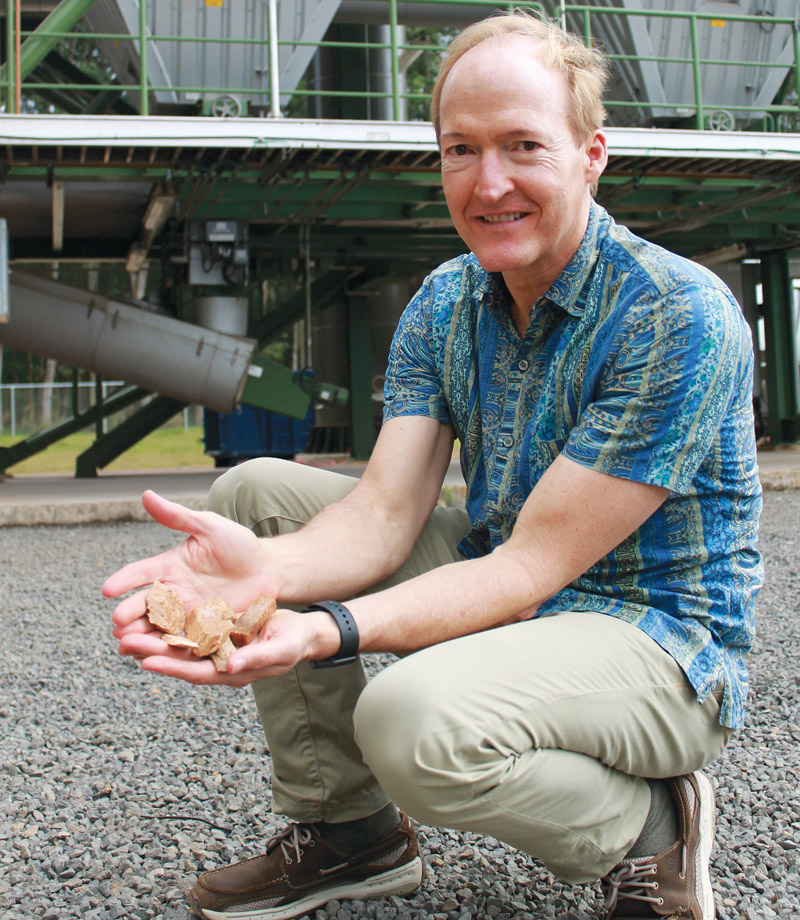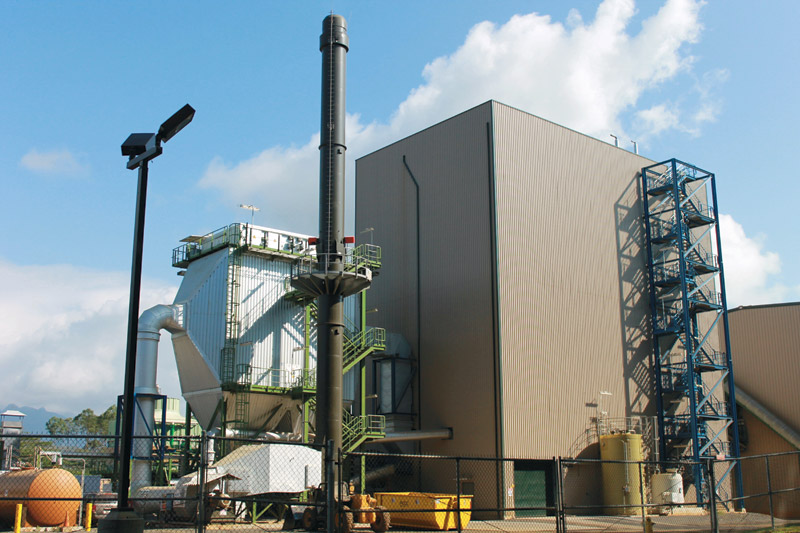Chipping Away at Fossil Fuel

The stacks of trees originate in Kokee, where they were damaged in a wildfire. They will be turned into wood chips and burned for energy
Kauai has something new to brag about in the renewable-energy department: a biomass plant that is the first of its kind in the country. The group that runs the operation, Green Energy Team (GE), recently started churning out approximately 12.4 percent of the island’s daily electrical needs in what U.S. Department of Agriculture’s Rural Utilities Service deems the only closed loop biomass-to-energy plant in the country.
In other words, the only biomass plant in the U.S. that is generating energy from its own supply of sources (aka wood chips) is in Koloa on the Garden Isle.
And here’s the kicker: GE is doing so by removing rapidly growing invasive species at the same time. “Today there are albizia infestations where you can’t do anything on the land,” says GE founder Eric Knutzen.
The group is clearing a total of 9,600 acres of albizia trees and, of those, 3,600 acres will be replanted with natural, non-GMO eucalyptus cultivars for the next 20 years. These crops will be harvested and cut for regrowth every four to five years. Additionally, on Kalepa, which is state land, at the end of its 20-year lease with GE, albizia stumps will be removed in order to provide clear, arable land that can be used for other purposes — such as growing food.
“This is a great improvement,” says Knutzen, who purchased the 64-acre Koloa land parcel from Eric K. Knudsen Trust to build the plant.
It will take several years to remove all of the albizia, and Knutzen actually looks forward to the day when they can use other wood varieties for chips. “It’s really porous, it’s really light,” says Knutzen regarding some of the drawbacks of using albizia wood. In other words, different sources — like eucalyptus — can provide even more energy output.
In the meantime, wood from trees other than albizia, such as Norfolk pines damaged in Kokee wildfires, also can be processed in the system. The combined total of wood chips incinerated per day is 163 “bone-dry” tons for a production of some 6.7 megawatts.
Despite the GE plant’s ability to wean the island off imported fossil fuels, some community members have expressed reluctance to embrace the effort because of the wood chip-burning process.
“People think you’re going to be polluting the air,” says Michael Mann, GE’s plant compliance and technology manager.
But the emissions generated from the plant are only one-fifth the nitrogen oxide and a third of the sulfur oxide output of older diesel generators, such as those at Kauai Island Utility Cooperative’s Port Allen plant. Less particulate matter — like soot — is released by GE than the older Port Allen diesel engine electrical production plant as well — particulate size is less than 1/30th the width of human hair.
“There’s nothing better than to actually see the fire raging inside the boiler and then walk right outside, look at the stack and see nothing coming out,” says Mann.
Moreover, the plant burns material at what is considered “clean” high temperatures between 1,500 and 1,700 degrees F. The Environmental Protection Agency also requires GE to measure air emissions on an ongoing basis.
“What we’re doing here is really responsible,” assures Mann.
So any wood-burning smells wafting into living rooms on the South Shore are not coming from the plant.
“I want to be completely transparent with what we’re doing here,” adds Mann, who invites people to visit the operation to see it in all its glory.
Knutzen has longed to bring a renewable energy source to the island for more than a decade. It all began during a conversation with late Kauai Mayor Bryan Baptiste about 12 years ago, when they discussed the island’s possibilities for generating its own energy. Knutzen eventually settled on biomass because it provides ongoing power — not intermittent, like solar — and doesn’t present issues like interfering with native wildlife (as windmills can). It also suits the plantation culture background of the island and is able to provide 39 full-time jobs year around.
“I like the environmental and social aspect of the project,” says Gilles Lebbe, a GE employee who has been working at the plant for five years. “It’s keeping money on the island and giving long-term jobs to the guys, and providing renewable power.”
The project corresponds with the state’s plan to move toward a 100 percent renewable energy future.
“There’s no doubt in my mind that we have the natural resources and access to everything that we need to be 100 percent renewable today. This is a great example,” said Gov. David Ige in April at the plant’s grand-opening celebration.
Kauai already is ahead of the game at 90 percent renewable energy at peak or “when the sun is shining,” says Ige. “Which really is an inspiration to the rest of the state.”
Knutzen doesn’t plan to stop providing clean energy when GE’s 20-year contract allowing KIUC to purchase power from the plant is up. “I would love to see this (the plant) replaced with something that’s even better,” he says.
For now, he’s proud of the current process that has and continues to be a massive team effort (thus, its moniker Green Energy Team). “It’s like a dream,” he says. “I just hope no one wakes me up.”
cocomidweek@gmail.com







